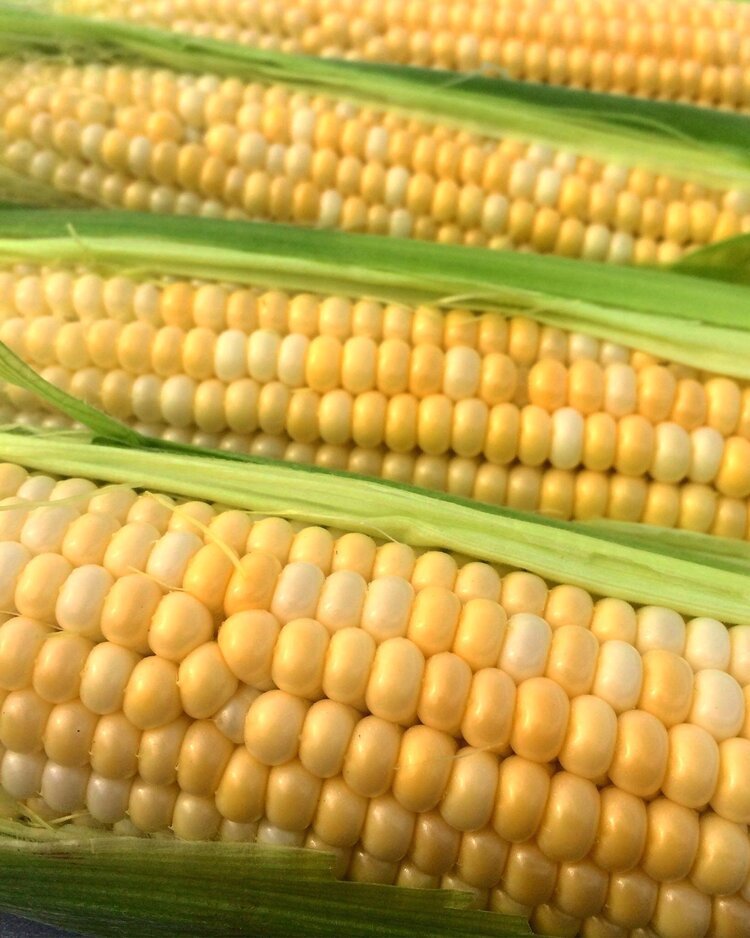Photography Tips for Farm Marketing
You know how beautiful your farm is. Why not share it with your customers? If you feel like you’re taking the same photos over and over, check out our tips below to freshen up your camera roll and give you a few more options next time you need photos for marketing.
Play with your food!
If you’re excited to show potential farm customers what you’re growing, let it show! Cut it open, take a bite out of it, make a kid or a dog hold it for the camera, etc. If you’re showing a cooked meal, try to photograph it outside or next to a window in natural light.
I was really excited to eat this giant chioggia beet. But guess which photo generated more traffic for my farm client on social media?
This was my first photo of the beet, trying to show how big it was…
…but this second photo is much more visually interesting because of the brighter colors and the fact that the food is taking up the whole frame.
Get on level with your subject
Whether it’s a three-foot heifer calf, a three-inch pepper plant, or a new PTO shaft cover for your three-point hitch, get on “eye level” with whatever you’re taking a photo of. This can make for a stronger composition, a more striking thumbnail on your customer’s social media feed, and gives a perspective that most people don’t ever get to see.
Take a look at these two photos of the same eggplant blossoms. Which one is more interesting?
These eggplant blossoms are an exciting sign of what’s to come, but they don’t look like much from above, especially to an unfamiliar eye.
This closer, eye-level photo shows more detail and lets the subject of the photo take up more space, making it more effective in communicating to the customer.
Farmers’ Eye View
Nobody else EVER gets to see an entire flatbed full of ripe watermelons, or thousands of germinating onion seeds in a greenhouse, or how tomato seedlings are grafted. These are the kinds of photos that will really connect your farm’s customers to how their food is grown and help them appreciate the effort and cost that goes into doing what you do.
If you’re feeling frustrated about a lack of consumer understanding about the issues that affect your work, this is also a positive, proactive way to educate the public. For example, if you find yourself biting your tongue when a customer asks where you go on vacation for the winter, why not make an effort to share photos of equipment repair, spreadsheets and seed catalogs on the kitchen table, market and association meetings, late nights in the barn during lambing, or plowing snow from the sides of the greenhouses?
Your view includes your perspective, even if it’s just your dusty boots at the end of the day.
Fresh disc on a long line…not something you get to see every day, but it’s really the nice sky that makes this picture post-worthy.
Rolling out row cover is not something the average customer factors into your routine, so show them!
Selfies are always better with animals—how many people get to snuggle cows?
Categorize
Think about the different kinds of photos you can make the best use of. Whether you’re trying to diversify your farm’s social media grid, or you need more pictures of how your farm operates for your co-op’s website, coming up with categories can help push you to be more creative and comprehensive about documenting your farm business. For example, maybe most of your photos are pictures of your market display. That could be a mental category called “harvest” or “picked.” If you expanded your categories to include “workers with produce,” “tractor work,” “veg in field,” and “landscapes,” you might still end up with all pictures of carrots, but they’d be lots of different, more interesting photos.
Take a look at these photos. They’re all about sweet corn, but they show more than just that.
The cornfield right before a storm. This shot has a sense of place, a sense of the weather, and shows your customer the process of growing through the summer.
Another farm landscape photo that shows the corn tasseling as harvest approaches, and shares the beauty of your work with customers.
This photo shows the process of picking corn on the morning of famers markets—it’s beautiful but it also shows how early farmers need to get up to feed customers!
This photo hints at the volume of corn being picked, and the expression of the farmer shows how good it feels to get it done! It’s always great to show people in your photos.
This is a fun photo that shows a glimpse of the barnyard while also communicating what’s going on on the farm. Animals are great for showing the sense of the moment.
Triumph! The first harvest of sweet corn just before going on the grill. Again, showing a person with your crop is key to connecting your customers to your farmers and their plate!
A clean appealing product shot of your crops can be tricky. Think about showing the part your customers will actually be eating and fill the camera frame. Natural outdoor light is always best, and it’s often easier to make raw ingredients look good than it is to make a finished dish look good.
Turn, Turn, Turn
Just like it’s good to have a wide variety of subjects in your photos, it’s good to have a wide variety of sizes and shapes of photos. You never know what you’ll end up using them for! When we’re starting a new farm website for a client, we always ask if they have any photos we can use on the site. If all the photos are oriented vertically like a portrait, or cropped to a square for Instagram, it’s tough to find enough photos to work for website page headers or even section illustrations. Try to remember to turn your camera when you’re taking pictures as a way to both experiment with cropping and to give yourself more variety to pick from in the future.
These three photos of lacinato kale were all taken in the exact same spot and they all have a very different feel.
This vertical photo would be great to show off your fields on social media.
This detail photo will get your lacinato aficionado customers excited for market day!
This horizontal photo shows the same view of the field, but its horizontal orientation will work better for some situations, like the heading of a farm email newsletter or on a slide in a presentation.
Outsourcing
If you have employees, don’t be afraid to ask them to send you any photos they take of their day. This is a great way to effectively be in many places at once. And who knows, one of your helpers might have a great eye! Make sure you always give photo credit when posting or using the photo. Be wary of handing over login information to your website or social media accounts too quickly, though. Not everyone has the same filter, and you want to make sure whatever your customers are seeing from you reflects your values and your voice.
The first cherry tomatoes in front of old tractors make an interesting composition and show a shift in the season.
Only the worker who breaks the fall of the carrots from the harvester’s arm gets the opportunity to show this view. Abundance is appealing.
It’s great to show who’s doing the work on your farm, especially if they’re having fun!
Technical Tips for Farm Photography on a Smartphone
Look at the lens of the camera you’re using. If it’s your phone that travels around the farm in your pocket all day, chances are it’s pretty dusty. Give it a good wipe to keep your photos looking as clear and in-focus as possible. If you have a heavy-duty or waterproof case on your phone, you might have to take the case off and clean the dust out of the part that covers your phone’s lens, too.
Touch that Touchscreen. If the photo coming out too dark, or you can’t get that zinnia in focus, simply try touching the point on your phone screen you want to stand out. Most smartphones now have a feature built-in where your camera will automatically adjust its exposure and focus to wherever you touch.
Avoid zooming in. Phone cameras don’t have optical zoom the way binoculars, telescopes, or SLR cameras do — digitally zooming doesn’t actually magnify the image. Zooming on your phone camera while taking a picture is exactly the same as taking a picture and then cropping it later. Plus, the pixels will be enlarged, giving you a grainy, fuzzy-looking image.
Edit judiciously. Don’t be afraid to edit your farm photos! Editing photos can make them easier to see and recognize immediately, making it easier for customers to engage. Play around with your camera’s editing program or with in-app editors like Instagram to see what you can do. If you’ve never edited photos before, the general rule of thumb is to edit it to the point where you think it’s right, and then dial your adjustments back a little. You don’t want to over-edit your photos to the point that the aesthetic distracts from the subject or your message. If you’re just trying it out, the best points to start playing with editing are exposure/brightness, contrast, and highlights/shadows. Once you learn what you can do with your editing tools, the job will go much faster, too.
Make space. Is your phone out of memory? You won’t be able to take any more photos until you clear up some space. If you’re not already backing up your photos to the Cloud, you can manually save them to a computer or hard drive using a built-in program like Image Capture, or even just dragging them from your phone’s pictures folder into a (labeled and organized) folder in your computer. Do yourself a favor and name the folder with the date every time you make a backup. That way, when you’re looking for tomato pictures in January, you’ll know to look in the June backup.






























For purposes of this comparison, we’re focusing solely on platforms that will enable you to have both your complete website and your online store together under one roof, so we’re zeroing in on GrazeCart vs. Shopify vs. Square.